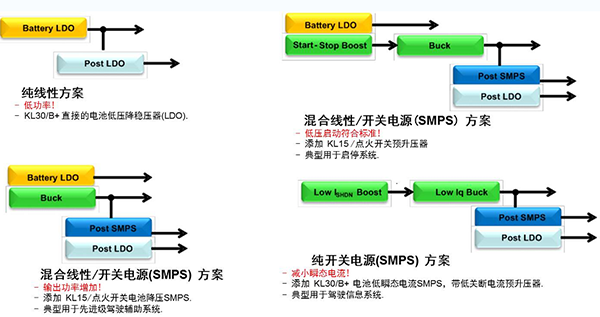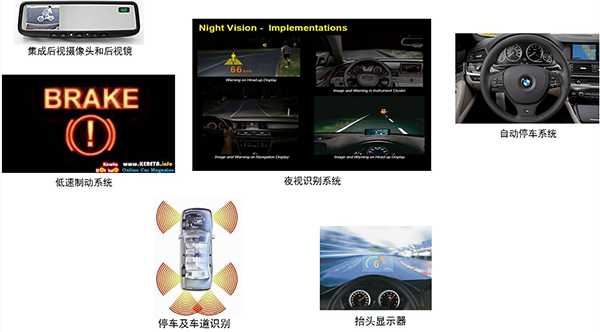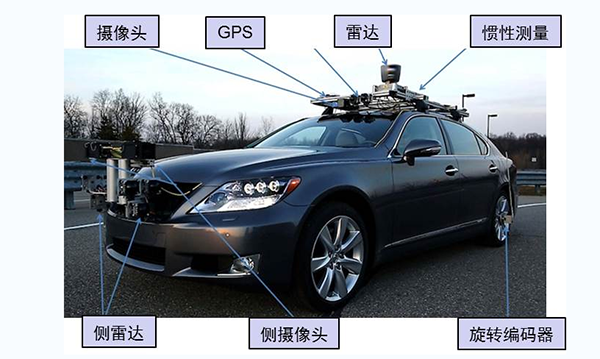ON Semiconductor analyzes automotive power transformation for you
Nowadays, with the increasing demand for convenience, safety, comfort and environmental protection and energy saving of automobiles, automobiles have evolved from mechanical parts to mechatronics, and they are increasingly dependent on electronic technology. As a result, more and more electronic modules are being integrated to provide more functionality to automotive users. However, this trend is also facing more challenges for automotive electronics engineers: the increase in digital components has led to a drop in supply voltage and the increase in current in components, coupled with increasingly stringent requirements for government regulations for carbon dioxide emissions, and consumer fuel economy. Requirements, engineers need to consider how to reduce power consumption, reduce quiescent current, improve system energy efficiency and comply with various environmental regulations and safety standards from the design of power management modules.
Power efficiency
Maximizing power efficiency has always been a core goal of design. From a thermodynamic point of view, the energy transfer in the real world is not perfect. Due to factors such as heat dissipation and other system losses, the input power can never be equal to the output power. This is measured by the power efficiency of the power supply, which is the ratio of the output power divided by the input power.
We assume that both the linear regulator and the switching power supply have a power rating of 2.5 W, and a 5 V output voltage and a 0.5 A output current, then the linear regulator requires 6 W of input power (the loss of 3.5 W is due to the regulator's heat dissipation). ), the energy efficiency is 41%, and the switching regulator requires only 2.8 W of input power, and the energy efficiency is as high as 90%.
Therefore, the switching scheme provides higher energy efficiency than the linear scheme. For designers, it is necessary to understand the design considerations from linear solutions to switching solutions and their impact on the design.
Switching power supply design considerations
According to the working principle of the switching power supply, the input voltage is increased/decreased/inverted by the on/off switching state, which is another advantage that the linear scheme can only reduce the input level. However, the switching scheme also has many drawbacks. Due to its complicated feedback loop, the external components are more linear than the linear scheme and require more PCB area, and the nature of the switch results in poor noise removal performance.
In order to alleviate the drawbacks of switching power supplies, system designers need to consider the following:
(1) Electromagnetic interference
Reduce loop area and optimize PCB layout to reduce interference between circuits;
Avoid sensitive frequency bands generated by the regulator and system environment;
Spread spectrum modulation techniques, spectral content and decoupling schemes are used to reduce emissions peaks.
(ii) Number of external components
The integrated power switch reduces wiring size, consumes less power than off-board power switches, and is easier to design.
(3) PCB area
By reducing the size of the inductor and capacitor, the PCB area is reduced, and the switching frequency is increased, which improves the energy efficiency and reduces the electromagnetic radiation and electromagnetic interference of the PCB. However, care should be taken to minimize conduction and switching losses and reduce noise.
(four) feedback loop design
Select a suitable negative input resistor for the post-regulator matching the output impedance to avoid oscillation and achieve the purpose of regulated output;
Effective use of simulation tools to understand frequency compensation in the frequency domain; frequency compensation can be achieved by selecting a unipolar response control scheme.
(5) Transient current
Parallel connection of the linear regulator and the switching power supply reduces the transient current, called a hybrid switching power supply; and pulse frequency modulation with constant on and off conditions depending on line load conditions.
Automotive system power topology evolution
Engineers must select the appropriate power management design for the automotive system, depending on the application.

Figure 1: Overview of the evolution of power system topology
Hybrid Linear/Switching Power Supply (SMPS) solutions are typically used in automotive ADAS systems and start-stop systems
With the increasing importance of active safety systems for vehicles, Advanced Driver Assistance Systems (ADAS) are gradually expanding from high-end vehicle applications to mid- to low-end vehicles, which provide a safer and more convenient driving experience by assisting the driver in controlling the complex process of the vehicle. Adapt to cruise control, blind spot monitoring, lane departure warning, night vision, lane keeping assistance, and collision warning systems with automatic steering and braking. The next-generation ADAS system will further automate the driving experience, such as: using the smart phone app to assist with automatic parking; equipped with V2X communication system to realize instant information exchange between vehicles and vehicles or vehicles and the external environment, thereby greatly alleviating traffic congestion and reducing traffic accidents. Occurs; identifies potential hazards through a media radar sensor platform, reacts sensitively and acts autonomously, providing multiple safety functions while reducing costs.

Figure 2: ADAS system
This requires a System Basis Chip (SBC) to be successfully connected to various parts of the vehicle such as cameras, GPS, radar and rotary encoders via communication technologies such as Ethernet. Due to the high level of integration complexity of the ADAS system, system designers need to select high-precision and customizable power and power modules for the power section, such as watchdog function, power monitoring redundancy, and voltage monitoring. To ensure the vehicle safety and integrity (ASLI) B rating in accordance with ISO26262, the vehicle's functional safety and safer driving experience.

Figure 3: Ethernet SBC technology to achieve the integration requirements of ADAS
With the implementation of fuel economy standards and regulated CO2 emission agreements, the market demand for start-stop systems is increasing. The so-called start-stop system, that is, automatically shuts off when the vehicle is temporarily parked during driving, and the system automatically restarts the internal combustion engine when it needs to continue, thereby reducing the idle time of the engine to reduce fuel consumption and carbon dioxide emissions.
The internal combustion engine cannot be started by itself, and an external force is required to initiate the combustion cycle. This is where the starter motor is used. When the ignition key is inserted and the switch is turned "on", the motor starts. However, the amount of current required to start the motor to crank the engine is very large, resulting in a significant drop in the car battery voltage during the start-up phase. To avoid voltage drop during the startup phase, the hybrid linear/SMPS scheme is further improved by adding a start-stop pre-boost between the buck regulator and the battery-powered LDO (as shown in the upper right corner of Figure 1), which is based on ignition. The switch opens and closes to meet the low pressure start of the start and stop system. Pre-boosters typically use high-power centralized multi-phase boosting and distributed low-power single-phase boosting to avoid anomalies caused by voltage dips and comply with the ISO16750 standard for 12V systems.
Switching power supply solutions are typically used in driving information systems
The driving information system includes information systems, communication systems, and entertainment systems inside and outside the vehicle, and is a major part of the development of automobiles. Information such as fuel consumption, speed, navigation, entertainment and ADAS systems can be displayed to the driver via the dashboard and central control panel. Vendors such as Nvidia and Intel continue to improve system integration capabilities and develop intelligent solutions that integrate and connect the functions of various vehicles through a graphics processor. Since a large amount of calculations are required inside the system, the driving information system is a high-power application, and a switching power supply scheme can be adopted. As a key technology for driving information systems, single-phase/multi-phase SMPS can perform dynamic voltage regulation according to real-time usage conditions, reducing unnecessary power consumption. The NCV8901 series from ON Semiconductor is a converter with integrated buck SMPS with an output current of 1.2A, an operating frequency of 2 MHz, an input voltage range of 4.5 V to 36 V, withstands 40V load-drain voltage, and the chip operating junction temperature is - 40 ° C to 150 ° C, small size, high output accuracy, can be used in driving information systems.
Car power goes to the 48 V system
In light of the ever-increasing demand/regulation of energy saving and emission reduction, the sales of light 48 V systems have been growing for nearly a decade. The 48 V structure consists of a 12 V and 48 V network. The two networks are connected by a bidirectional output SMPS. Combined with a traditional 12 V or 14 V network, the lead-acid battery is used like most conventional vehicles. A 48 V Li-Ion battery is equipped with a separate 48 V network. The 12 V network handles traditional loads: lighting, ignition, entertainment, audio systems, and electronic modules. The 48 V system supports active undercarriage, air conditioning compressors and regenerative braking. The key advantage of the 48 V structure is that it combines the advantages of dual pressure settings with the well-known start-stop technology to more effectively capture vehicle braking energy, provide higher power for ever-increasing electrical loads, and increase fuel consumption by up to 15%. Energy efficiency; in addition, it reduces the current delivered to the load and reduces the weight of the harness to improve power efficiency.
Conclusion
The complexity of power management modules related to the automotive industry continues to grow, linear regulators can no longer meet the demand for energy efficiency, and evolved a hybrid switching power supply with linear regulators and switching power supplies in parallel, typically used in ADAS systems and start-stop systems. And switching power supplies are typically used in driving information systems, and even 48 V architectures/systems that are still discussed but can further improve fuel efficiency, enabling energy efficiency and energy consumption to be maximized in both low-power and high-power applications. The government's environmental regulations and safety standards meet the fuel economy requirements of automotive consumers.
The IDA system is a new product that Sinco has put on the market in recent years. IDA is an abbreviation for Intelligent Data Collection. The main components of the system are: sensors, multi-channel modules, interface repeaters, terminal boxes, I/R modules, power supplies, personal computers, sensing cables, buses, various lightning protectors, bus power controllers, overvoltages Protector, manual reading adapter and portable reading display, etc. The multi-channel module converts the sensor signal into a digital form and transmits it to the personal computer on site via the IDA bus. The PC will convert the data obtained from the engineering unit and save it to a floppy disk. If necessary, the PC can also analyze and compare the input data to preset alarm limits and issue alarms. Data can be printed, displayed, and can be repeatedly returned from the front PC to the rear PC for many times. The front PC is used for data recording and the rear is used for data analysis, and the data is transmitted by modem or floppy disk. The rear PC is responsible for data archiving, data analysis, drawing and report generation of the database. The Tennessee Engineering Administration (TVA) in the United States adopted IDAS in the monitoring of the Fontena Dam. The system works well and can also be used for the monitoring of landslides and tailings dams.
Efficient Unit Box,Data Acquisition Box,Data Acquisition Unit Box,Integrated Data Acquisition Box
Shenzhen Scodeno Technology Co.,Ltd , https://www.scodenonet.com